Policy Analysis: Aged Care Reforms, Health Outcomes in Australia
VerifiedAdded on 2022/08/20
|14
|4582
|21
Essay
AI Summary
This essay provides a detailed policy analysis of aged care reforms in Australia, utilizing the Australian Policy Cycle as a framework. It explores the development and implementation of healthcare policies related to aged care, addressing issues such as the National Health Priorities, determinants of health, political influence, equity of healthcare services, the impact of media, and evidence-based policy. The analysis considers the increasing aged population, the need for healthcare resources, and the ethical and legal dilemmas affecting policy formulation. It evaluates the Aged Care Reforms in Australia, highlighting improvements in community and residential care, and discusses the pressures faced by the aged care industry due to demographic changes, technological advancements, and evolving policy standards. The essay concludes by emphasizing the importance of addressing these factors for the effective implementation of aged healthcare policies and the well-being of older adults.
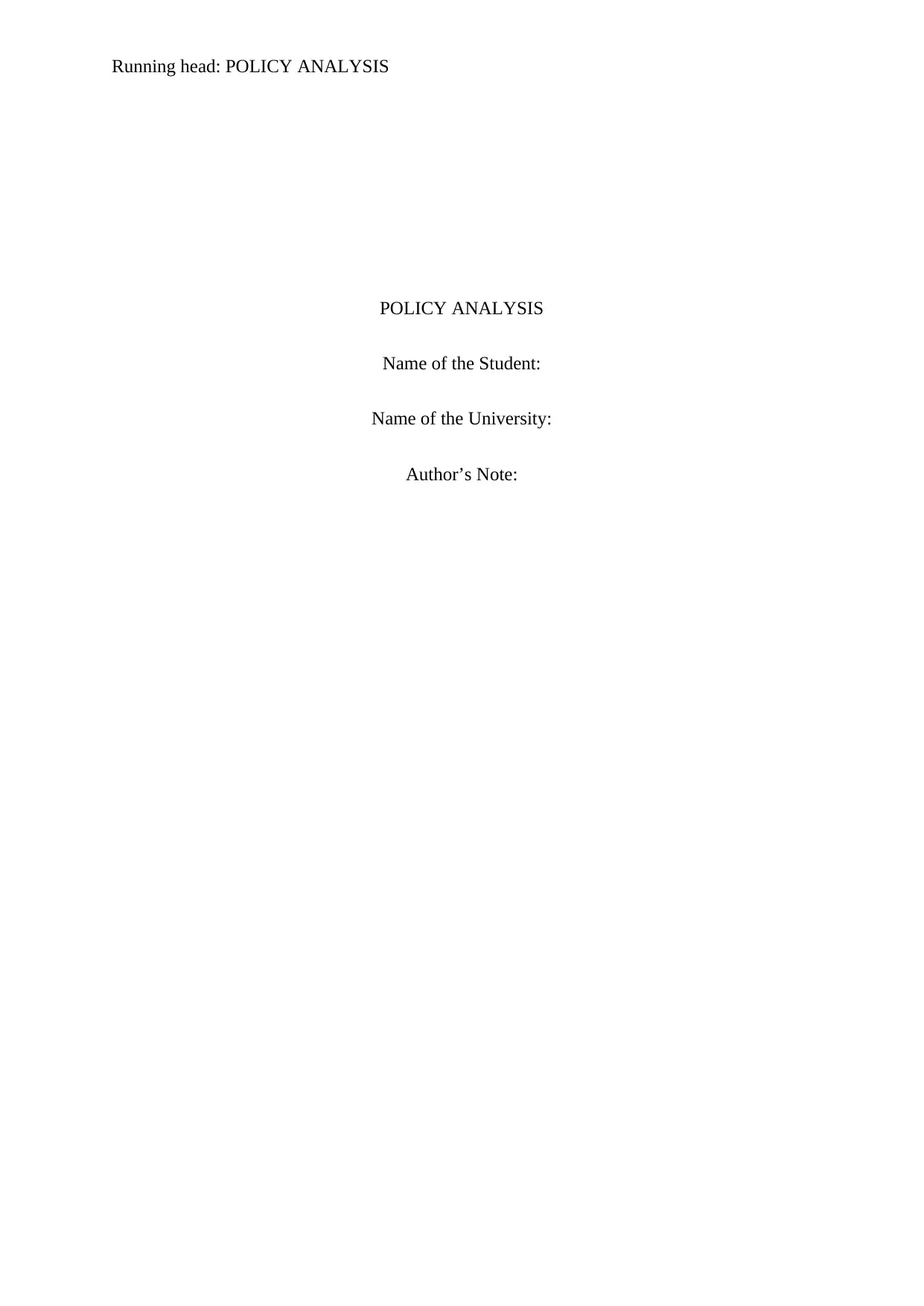
Running head: POLICY ANALYSIS
POLICY ANALYSIS
Name of the Student:
Name of the University:
Author’s Note:
POLICY ANALYSIS
Name of the Student:
Name of the University:
Author’s Note:
Paraphrase This Document
Need a fresh take? Get an instant paraphrase of this document with our AI Paraphraser
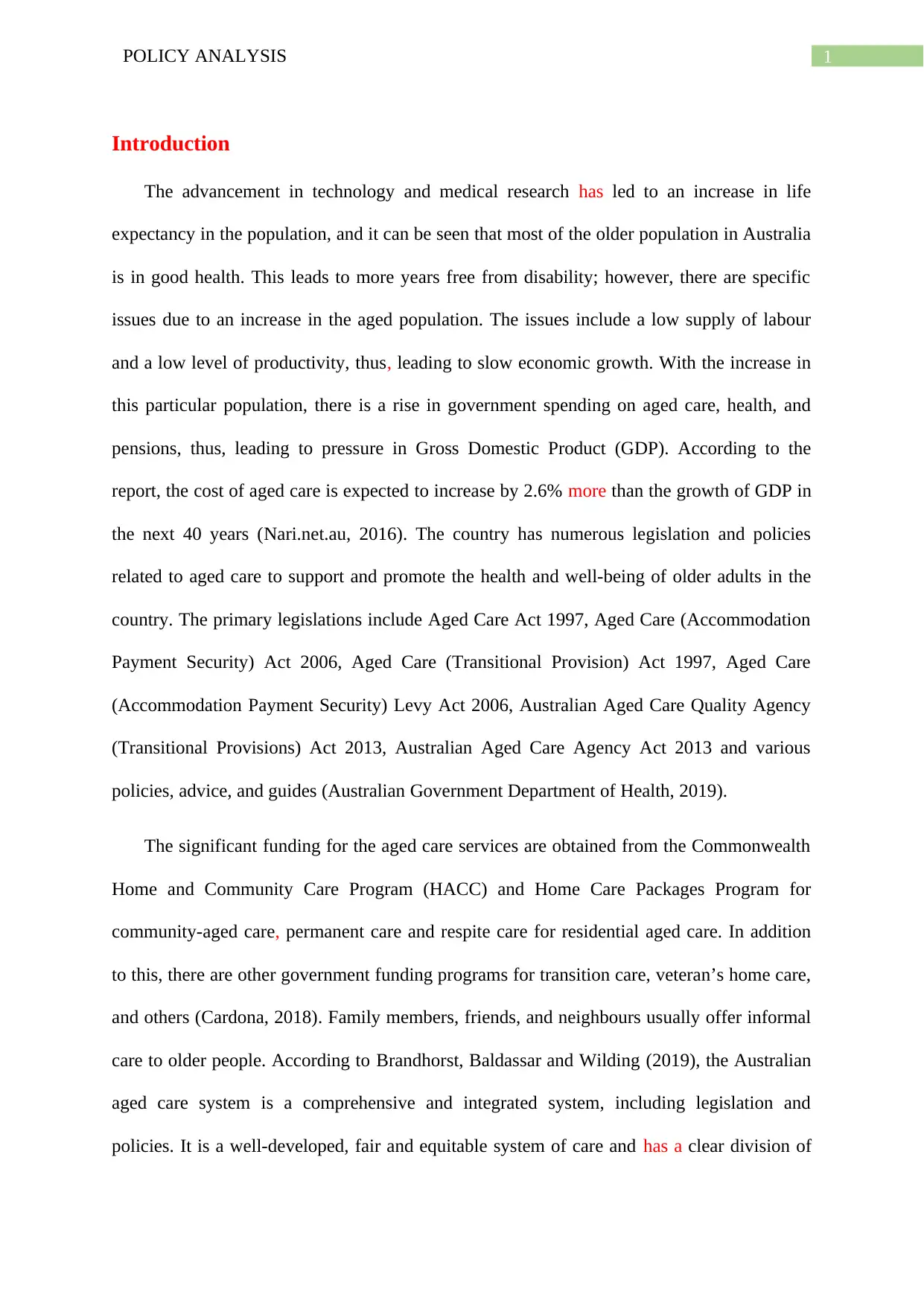
1POLICY ANALYSIS
Introduction
The advancement in technology and medical research has led to an increase in life
expectancy in the population, and it can be seen that most of the older population in Australia
is in good health. This leads to more years free from disability; however, there are specific
issues due to an increase in the aged population. The issues include a low supply of labour
and a low level of productivity, thus, leading to slow economic growth. With the increase in
this particular population, there is a rise in government spending on aged care, health, and
pensions, thus, leading to pressure in Gross Domestic Product (GDP). According to the
report, the cost of aged care is expected to increase by 2.6% more than the growth of GDP in
the next 40 years (Nari.net.au, 2016). The country has numerous legislation and policies
related to aged care to support and promote the health and well-being of older adults in the
country. The primary legislations include Aged Care Act 1997, Aged Care (Accommodation
Payment Security) Act 2006, Aged Care (Transitional Provision) Act 1997, Aged Care
(Accommodation Payment Security) Levy Act 2006, Australian Aged Care Quality Agency
(Transitional Provisions) Act 2013, Australian Aged Care Agency Act 2013 and various
policies, advice, and guides (Australian Government Department of Health, 2019).
The significant funding for the aged care services are obtained from the Commonwealth
Home and Community Care Program (HACC) and Home Care Packages Program for
community-aged care, permanent care and respite care for residential aged care. In addition
to this, there are other government funding programs for transition care, veteran’s home care,
and others (Cardona, 2018). Family members, friends, and neighbours usually offer informal
care to older people. According to Brandhorst, Baldassar and Wilding (2019), the Australian
aged care system is a comprehensive and integrated system, including legislation and
policies. It is a well-developed, fair and equitable system of care and has a clear division of
Introduction
The advancement in technology and medical research has led to an increase in life
expectancy in the population, and it can be seen that most of the older population in Australia
is in good health. This leads to more years free from disability; however, there are specific
issues due to an increase in the aged population. The issues include a low supply of labour
and a low level of productivity, thus, leading to slow economic growth. With the increase in
this particular population, there is a rise in government spending on aged care, health, and
pensions, thus, leading to pressure in Gross Domestic Product (GDP). According to the
report, the cost of aged care is expected to increase by 2.6% more than the growth of GDP in
the next 40 years (Nari.net.au, 2016). The country has numerous legislation and policies
related to aged care to support and promote the health and well-being of older adults in the
country. The primary legislations include Aged Care Act 1997, Aged Care (Accommodation
Payment Security) Act 2006, Aged Care (Transitional Provision) Act 1997, Aged Care
(Accommodation Payment Security) Levy Act 2006, Australian Aged Care Quality Agency
(Transitional Provisions) Act 2013, Australian Aged Care Agency Act 2013 and various
policies, advice, and guides (Australian Government Department of Health, 2019).
The significant funding for the aged care services are obtained from the Commonwealth
Home and Community Care Program (HACC) and Home Care Packages Program for
community-aged care, permanent care and respite care for residential aged care. In addition
to this, there are other government funding programs for transition care, veteran’s home care,
and others (Cardona, 2018). Family members, friends, and neighbours usually offer informal
care to older people. According to Brandhorst, Baldassar and Wilding (2019), the Australian
aged care system is a comprehensive and integrated system, including legislation and
policies. It is a well-developed, fair and equitable system of care and has a clear division of
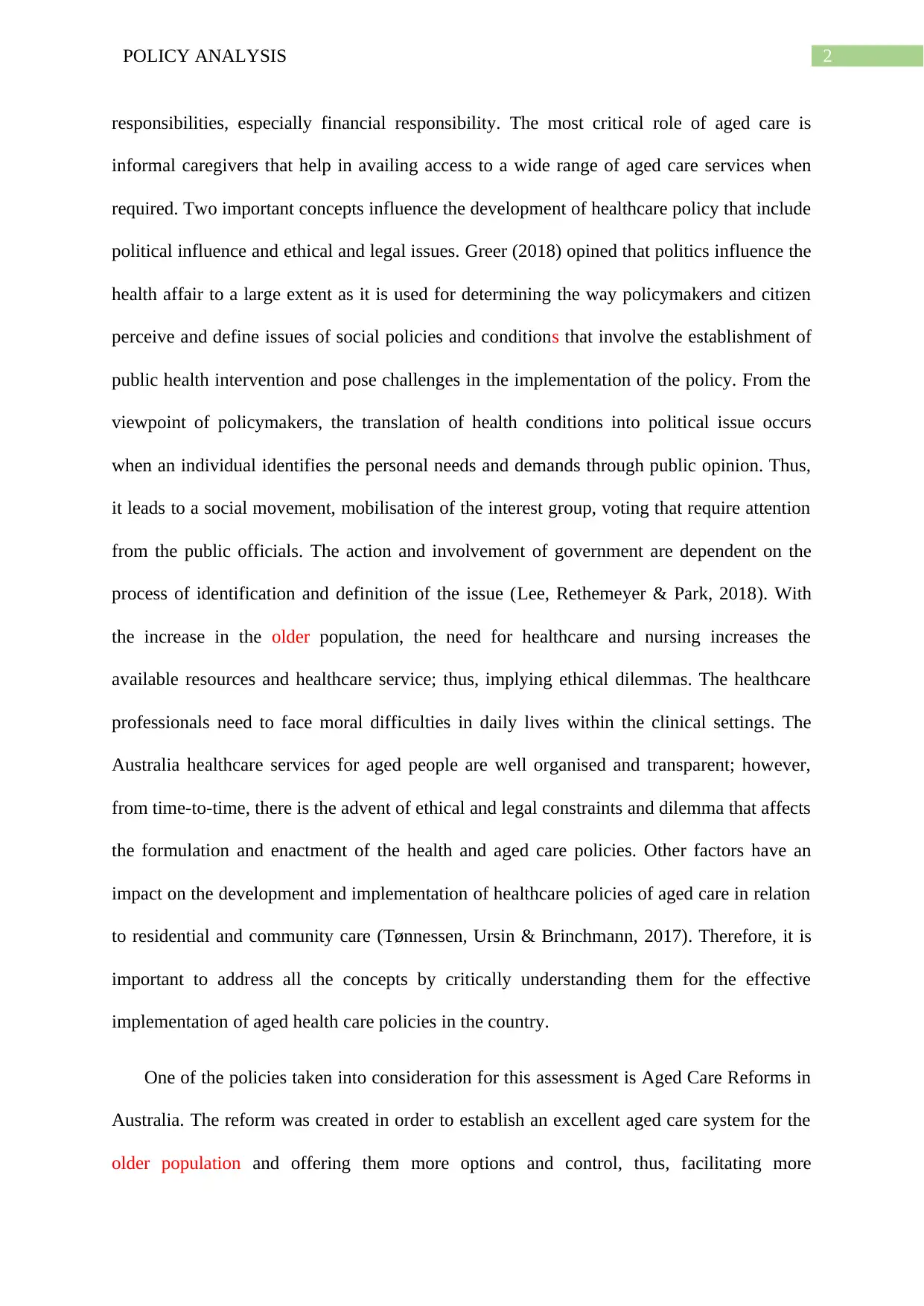
2POLICY ANALYSIS
responsibilities, especially financial responsibility. The most critical role of aged care is
informal caregivers that help in availing access to a wide range of aged care services when
required. Two important concepts influence the development of healthcare policy that include
political influence and ethical and legal issues. Greer (2018) opined that politics influence the
health affair to a large extent as it is used for determining the way policymakers and citizen
perceive and define issues of social policies and conditions that involve the establishment of
public health intervention and pose challenges in the implementation of the policy. From the
viewpoint of policymakers, the translation of health conditions into political issue occurs
when an individual identifies the personal needs and demands through public opinion. Thus,
it leads to a social movement, mobilisation of the interest group, voting that require attention
from the public officials. The action and involvement of government are dependent on the
process of identification and definition of the issue (Lee, Rethemeyer & Park, 2018). With
the increase in the older population, the need for healthcare and nursing increases the
available resources and healthcare service; thus, implying ethical dilemmas. The healthcare
professionals need to face moral difficulties in daily lives within the clinical settings. The
Australia healthcare services for aged people are well organised and transparent; however,
from time-to-time, there is the advent of ethical and legal constraints and dilemma that affects
the formulation and enactment of the health and aged care policies. Other factors have an
impact on the development and implementation of healthcare policies of aged care in relation
to residential and community care (Tønnessen, Ursin & Brinchmann, 2017). Therefore, it is
important to address all the concepts by critically understanding them for the effective
implementation of aged health care policies in the country.
One of the policies taken into consideration for this assessment is Aged Care Reforms in
Australia. The reform was created in order to establish an excellent aged care system for the
older population and offering them more options and control, thus, facilitating more
responsibilities, especially financial responsibility. The most critical role of aged care is
informal caregivers that help in availing access to a wide range of aged care services when
required. Two important concepts influence the development of healthcare policy that include
political influence and ethical and legal issues. Greer (2018) opined that politics influence the
health affair to a large extent as it is used for determining the way policymakers and citizen
perceive and define issues of social policies and conditions that involve the establishment of
public health intervention and pose challenges in the implementation of the policy. From the
viewpoint of policymakers, the translation of health conditions into political issue occurs
when an individual identifies the personal needs and demands through public opinion. Thus,
it leads to a social movement, mobilisation of the interest group, voting that require attention
from the public officials. The action and involvement of government are dependent on the
process of identification and definition of the issue (Lee, Rethemeyer & Park, 2018). With
the increase in the older population, the need for healthcare and nursing increases the
available resources and healthcare service; thus, implying ethical dilemmas. The healthcare
professionals need to face moral difficulties in daily lives within the clinical settings. The
Australia healthcare services for aged people are well organised and transparent; however,
from time-to-time, there is the advent of ethical and legal constraints and dilemma that affects
the formulation and enactment of the health and aged care policies. Other factors have an
impact on the development and implementation of healthcare policies of aged care in relation
to residential and community care (Tønnessen, Ursin & Brinchmann, 2017). Therefore, it is
important to address all the concepts by critically understanding them for the effective
implementation of aged health care policies in the country.
One of the policies taken into consideration for this assessment is Aged Care Reforms in
Australia. The reform was created in order to establish an excellent aged care system for the
older population and offering them more options and control, thus, facilitating more
⊘ This is a preview!⊘
Do you want full access?
Subscribe today to unlock all pages.

Trusted by 1+ million students worldwide
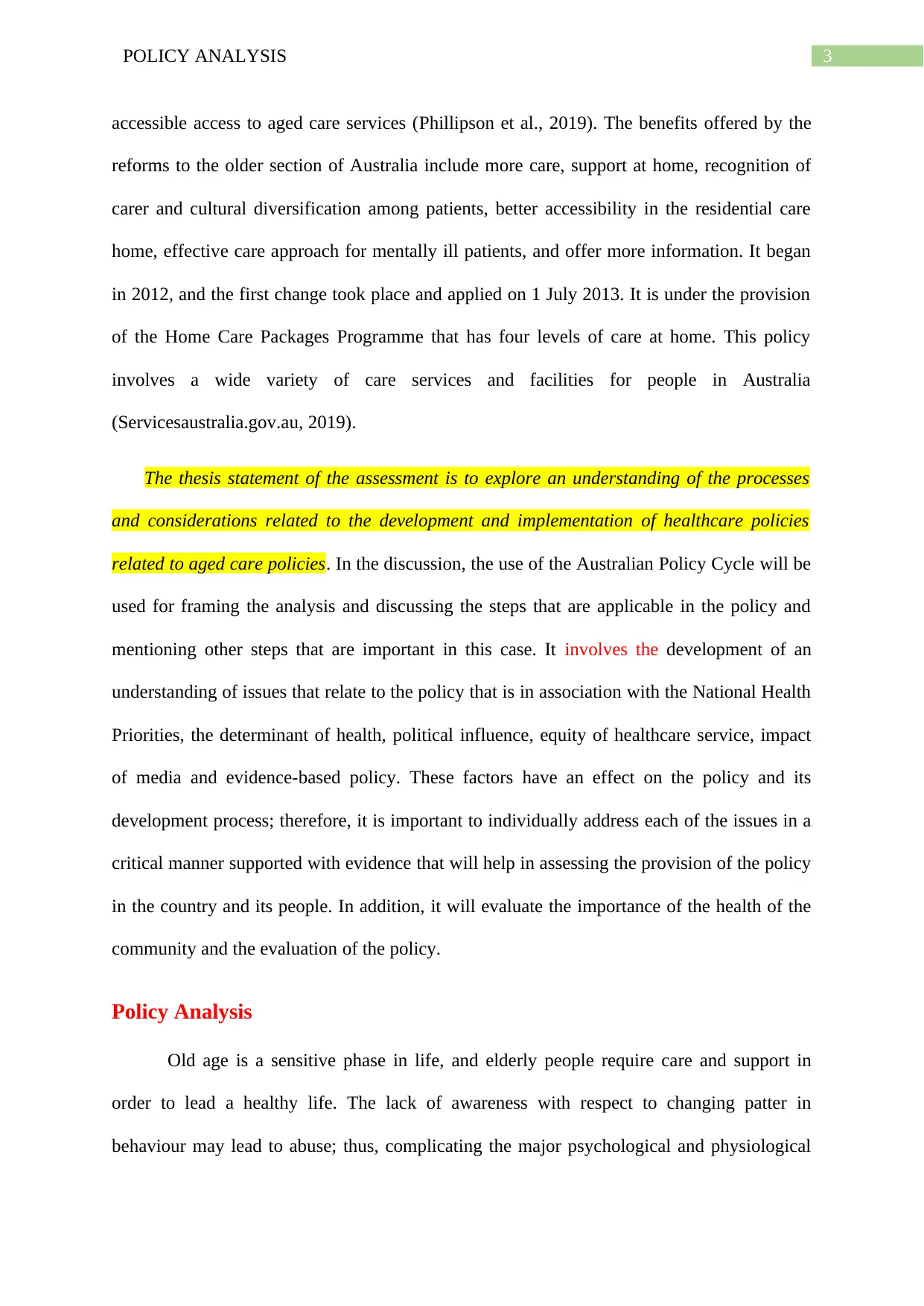
3POLICY ANALYSIS
accessible access to aged care services (Phillipson et al., 2019). The benefits offered by the
reforms to the older section of Australia include more care, support at home, recognition of
carer and cultural diversification among patients, better accessibility in the residential care
home, effective care approach for mentally ill patients, and offer more information. It began
in 2012, and the first change took place and applied on 1 July 2013. It is under the provision
of the Home Care Packages Programme that has four levels of care at home. This policy
involves a wide variety of care services and facilities for people in Australia
(Servicesaustralia.gov.au, 2019).
The thesis statement of the assessment is to explore an understanding of the processes
and considerations related to the development and implementation of healthcare policies
related to aged care policies. In the discussion, the use of the Australian Policy Cycle will be
used for framing the analysis and discussing the steps that are applicable in the policy and
mentioning other steps that are important in this case. It involves the development of an
understanding of issues that relate to the policy that is in association with the National Health
Priorities, the determinant of health, political influence, equity of healthcare service, impact
of media and evidence-based policy. These factors have an effect on the policy and its
development process; therefore, it is important to individually address each of the issues in a
critical manner supported with evidence that will help in assessing the provision of the policy
in the country and its people. In addition, it will evaluate the importance of the health of the
community and the evaluation of the policy.
Policy Analysis
Old age is a sensitive phase in life, and elderly people require care and support in
order to lead a healthy life. The lack of awareness with respect to changing patter in
behaviour may lead to abuse; thus, complicating the major psychological and physiological
accessible access to aged care services (Phillipson et al., 2019). The benefits offered by the
reforms to the older section of Australia include more care, support at home, recognition of
carer and cultural diversification among patients, better accessibility in the residential care
home, effective care approach for mentally ill patients, and offer more information. It began
in 2012, and the first change took place and applied on 1 July 2013. It is under the provision
of the Home Care Packages Programme that has four levels of care at home. This policy
involves a wide variety of care services and facilities for people in Australia
(Servicesaustralia.gov.au, 2019).
The thesis statement of the assessment is to explore an understanding of the processes
and considerations related to the development and implementation of healthcare policies
related to aged care policies. In the discussion, the use of the Australian Policy Cycle will be
used for framing the analysis and discussing the steps that are applicable in the policy and
mentioning other steps that are important in this case. It involves the development of an
understanding of issues that relate to the policy that is in association with the National Health
Priorities, the determinant of health, political influence, equity of healthcare service, impact
of media and evidence-based policy. These factors have an effect on the policy and its
development process; therefore, it is important to individually address each of the issues in a
critical manner supported with evidence that will help in assessing the provision of the policy
in the country and its people. In addition, it will evaluate the importance of the health of the
community and the evaluation of the policy.
Policy Analysis
Old age is a sensitive phase in life, and elderly people require care and support in
order to lead a healthy life. The lack of awareness with respect to changing patter in
behaviour may lead to abuse; thus, complicating the major psychological and physiological
Paraphrase This Document
Need a fresh take? Get an instant paraphrase of this document with our AI Paraphraser
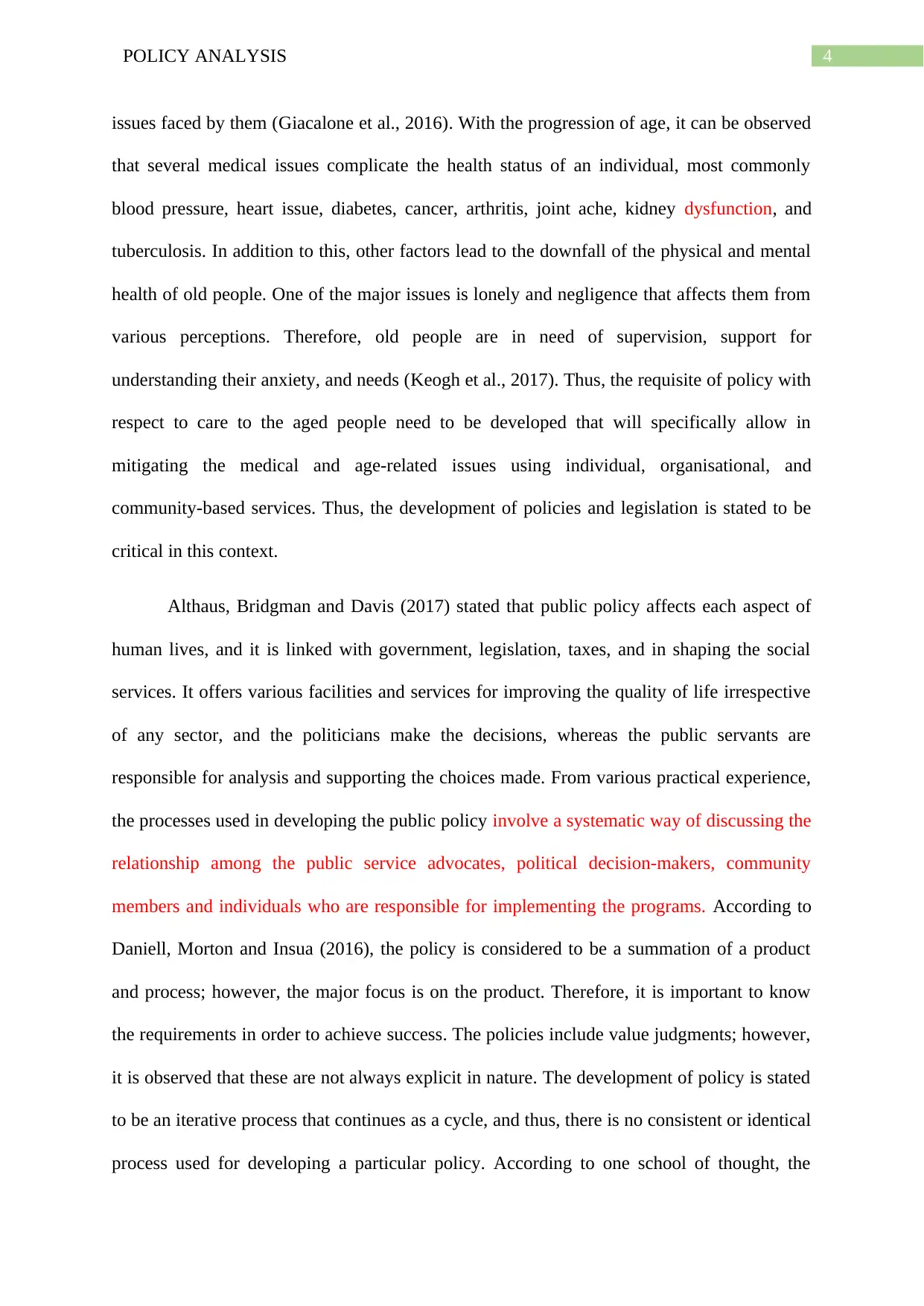
4POLICY ANALYSIS
issues faced by them (Giacalone et al., 2016). With the progression of age, it can be observed
that several medical issues complicate the health status of an individual, most commonly
blood pressure, heart issue, diabetes, cancer, arthritis, joint ache, kidney dysfunction, and
tuberculosis. In addition to this, other factors lead to the downfall of the physical and mental
health of old people. One of the major issues is lonely and negligence that affects them from
various perceptions. Therefore, old people are in need of supervision, support for
understanding their anxiety, and needs (Keogh et al., 2017). Thus, the requisite of policy with
respect to care to the aged people need to be developed that will specifically allow in
mitigating the medical and age-related issues using individual, organisational, and
community-based services. Thus, the development of policies and legislation is stated to be
critical in this context.
Althaus, Bridgman and Davis (2017) stated that public policy affects each aspect of
human lives, and it is linked with government, legislation, taxes, and in shaping the social
services. It offers various facilities and services for improving the quality of life irrespective
of any sector, and the politicians make the decisions, whereas the public servants are
responsible for analysis and supporting the choices made. From various practical experience,
the processes used in developing the public policy involve a systematic way of discussing the
relationship among the public service advocates, political decision-makers, community
members and individuals who are responsible for implementing the programs. According to
Daniell, Morton and Insua (2016), the policy is considered to be a summation of a product
and process; however, the major focus is on the product. Therefore, it is important to know
the requirements in order to achieve success. The policies include value judgments; however,
it is observed that these are not always explicit in nature. The development of policy is stated
to be an iterative process that continues as a cycle, and thus, there is no consistent or identical
process used for developing a particular policy. According to one school of thought, the
issues faced by them (Giacalone et al., 2016). With the progression of age, it can be observed
that several medical issues complicate the health status of an individual, most commonly
blood pressure, heart issue, diabetes, cancer, arthritis, joint ache, kidney dysfunction, and
tuberculosis. In addition to this, other factors lead to the downfall of the physical and mental
health of old people. One of the major issues is lonely and negligence that affects them from
various perceptions. Therefore, old people are in need of supervision, support for
understanding their anxiety, and needs (Keogh et al., 2017). Thus, the requisite of policy with
respect to care to the aged people need to be developed that will specifically allow in
mitigating the medical and age-related issues using individual, organisational, and
community-based services. Thus, the development of policies and legislation is stated to be
critical in this context.
Althaus, Bridgman and Davis (2017) stated that public policy affects each aspect of
human lives, and it is linked with government, legislation, taxes, and in shaping the social
services. It offers various facilities and services for improving the quality of life irrespective
of any sector, and the politicians make the decisions, whereas the public servants are
responsible for analysis and supporting the choices made. From various practical experience,
the processes used in developing the public policy involve a systematic way of discussing the
relationship among the public service advocates, political decision-makers, community
members and individuals who are responsible for implementing the programs. According to
Daniell, Morton and Insua (2016), the policy is considered to be a summation of a product
and process; however, the major focus is on the product. Therefore, it is important to know
the requirements in order to achieve success. The policies include value judgments; however,
it is observed that these are not always explicit in nature. The development of policy is stated
to be an iterative process that continues as a cycle, and thus, there is no consistent or identical
process used for developing a particular policy. According to one school of thought, the
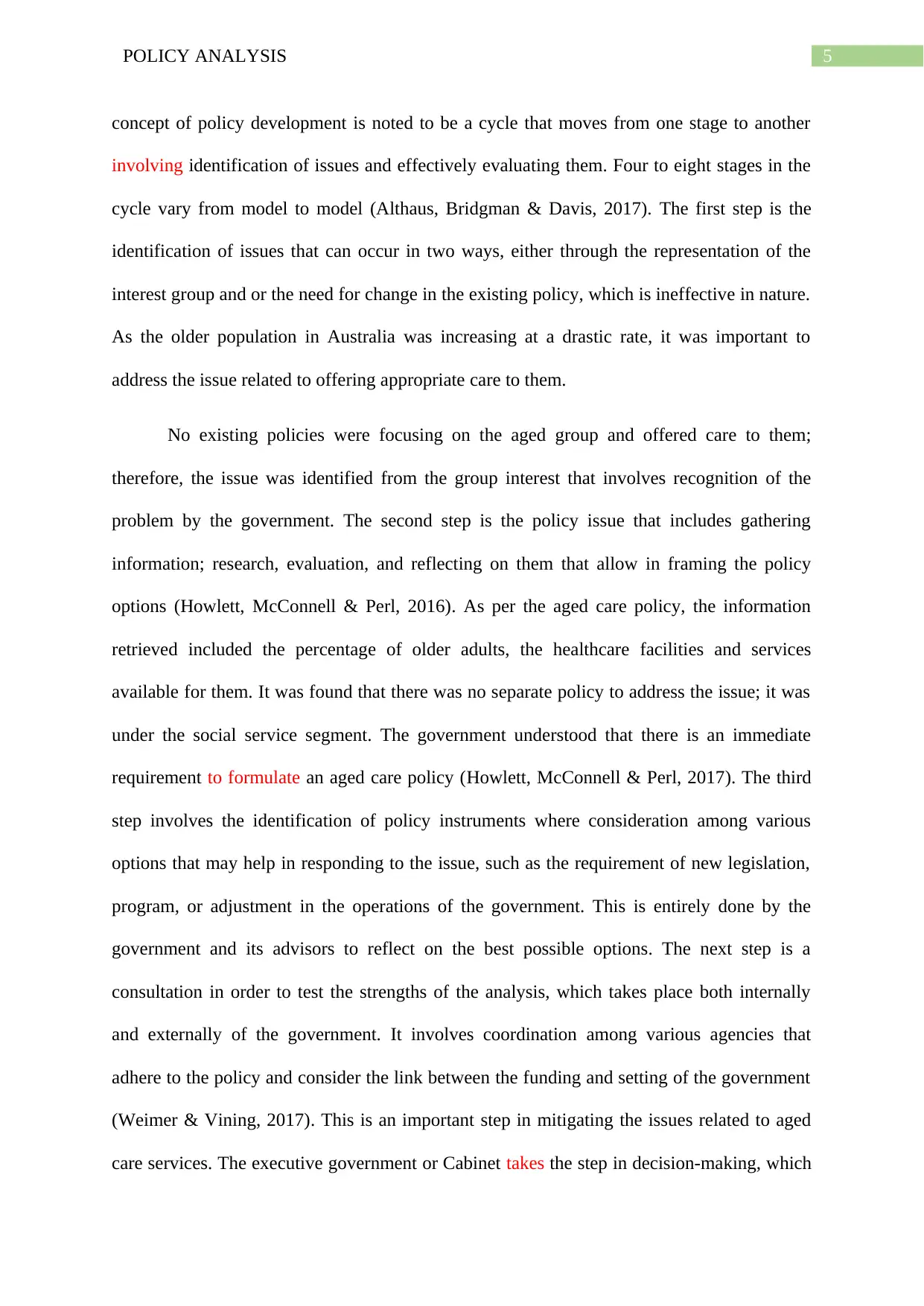
5POLICY ANALYSIS
concept of policy development is noted to be a cycle that moves from one stage to another
involving identification of issues and effectively evaluating them. Four to eight stages in the
cycle vary from model to model (Althaus, Bridgman & Davis, 2017). The first step is the
identification of issues that can occur in two ways, either through the representation of the
interest group and or the need for change in the existing policy, which is ineffective in nature.
As the older population in Australia was increasing at a drastic rate, it was important to
address the issue related to offering appropriate care to them.
No existing policies were focusing on the aged group and offered care to them;
therefore, the issue was identified from the group interest that involves recognition of the
problem by the government. The second step is the policy issue that includes gathering
information; research, evaluation, and reflecting on them that allow in framing the policy
options (Howlett, McConnell & Perl, 2016). As per the aged care policy, the information
retrieved included the percentage of older adults, the healthcare facilities and services
available for them. It was found that there was no separate policy to address the issue; it was
under the social service segment. The government understood that there is an immediate
requirement to formulate an aged care policy (Howlett, McConnell & Perl, 2017). The third
step involves the identification of policy instruments where consideration among various
options that may help in responding to the issue, such as the requirement of new legislation,
program, or adjustment in the operations of the government. This is entirely done by the
government and its advisors to reflect on the best possible options. The next step is a
consultation in order to test the strengths of the analysis, which takes place both internally
and externally of the government. It involves coordination among various agencies that
adhere to the policy and consider the link between the funding and setting of the government
(Weimer & Vining, 2017). This is an important step in mitigating the issues related to aged
care services. The executive government or Cabinet takes the step in decision-making, which
concept of policy development is noted to be a cycle that moves from one stage to another
involving identification of issues and effectively evaluating them. Four to eight stages in the
cycle vary from model to model (Althaus, Bridgman & Davis, 2017). The first step is the
identification of issues that can occur in two ways, either through the representation of the
interest group and or the need for change in the existing policy, which is ineffective in nature.
As the older population in Australia was increasing at a drastic rate, it was important to
address the issue related to offering appropriate care to them.
No existing policies were focusing on the aged group and offered care to them;
therefore, the issue was identified from the group interest that involves recognition of the
problem by the government. The second step is the policy issue that includes gathering
information; research, evaluation, and reflecting on them that allow in framing the policy
options (Howlett, McConnell & Perl, 2016). As per the aged care policy, the information
retrieved included the percentage of older adults, the healthcare facilities and services
available for them. It was found that there was no separate policy to address the issue; it was
under the social service segment. The government understood that there is an immediate
requirement to formulate an aged care policy (Howlett, McConnell & Perl, 2017). The third
step involves the identification of policy instruments where consideration among various
options that may help in responding to the issue, such as the requirement of new legislation,
program, or adjustment in the operations of the government. This is entirely done by the
government and its advisors to reflect on the best possible options. The next step is a
consultation in order to test the strengths of the analysis, which takes place both internally
and externally of the government. It involves coordination among various agencies that
adhere to the policy and consider the link between the funding and setting of the government
(Weimer & Vining, 2017). This is an important step in mitigating the issues related to aged
care services. The executive government or Cabinet takes the step in decision-making, which
⊘ This is a preview!⊘
Do you want full access?
Subscribe today to unlock all pages.

Trusted by 1+ million students worldwide
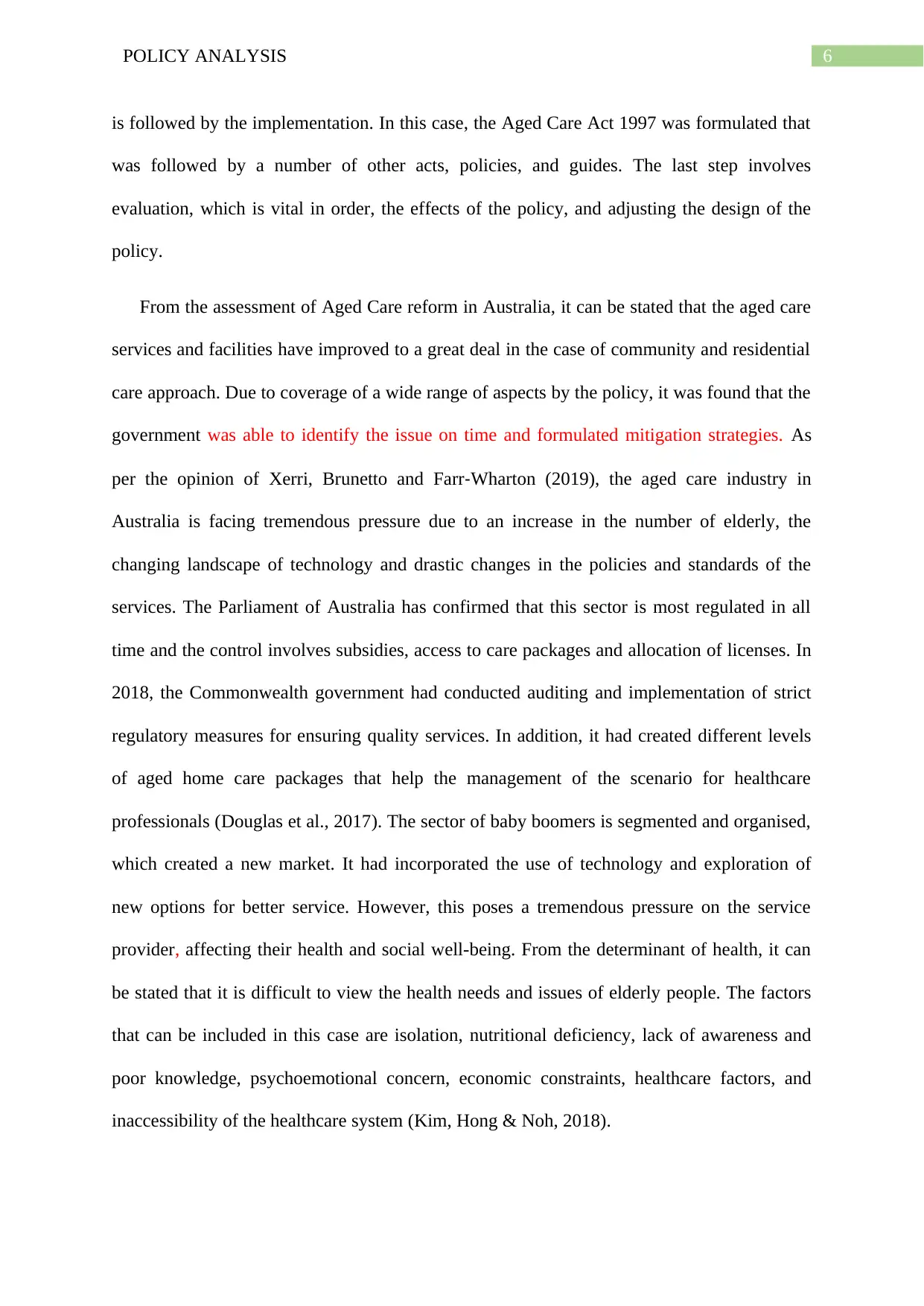
6POLICY ANALYSIS
is followed by the implementation. In this case, the Aged Care Act 1997 was formulated that
was followed by a number of other acts, policies, and guides. The last step involves
evaluation, which is vital in order, the effects of the policy, and adjusting the design of the
policy.
From the assessment of Aged Care reform in Australia, it can be stated that the aged care
services and facilities have improved to a great deal in the case of community and residential
care approach. Due to coverage of a wide range of aspects by the policy, it was found that the
government was able to identify the issue on time and formulated mitigation strategies. As
per the opinion of Xerri, Brunetto and Farr‐Wharton (2019), the aged care industry in
Australia is facing tremendous pressure due to an increase in the number of elderly, the
changing landscape of technology and drastic changes in the policies and standards of the
services. The Parliament of Australia has confirmed that this sector is most regulated in all
time and the control involves subsidies, access to care packages and allocation of licenses. In
2018, the Commonwealth government had conducted auditing and implementation of strict
regulatory measures for ensuring quality services. In addition, it had created different levels
of aged home care packages that help the management of the scenario for healthcare
professionals (Douglas et al., 2017). The sector of baby boomers is segmented and organised,
which created a new market. It had incorporated the use of technology and exploration of
new options for better service. However, this poses a tremendous pressure on the service
provider, affecting their health and social well-being. From the determinant of health, it can
be stated that it is difficult to view the health needs and issues of elderly people. The factors
that can be included in this case are isolation, nutritional deficiency, lack of awareness and
poor knowledge, psychoemotional concern, economic constraints, healthcare factors, and
inaccessibility of the healthcare system (Kim, Hong & Noh, 2018).
is followed by the implementation. In this case, the Aged Care Act 1997 was formulated that
was followed by a number of other acts, policies, and guides. The last step involves
evaluation, which is vital in order, the effects of the policy, and adjusting the design of the
policy.
From the assessment of Aged Care reform in Australia, it can be stated that the aged care
services and facilities have improved to a great deal in the case of community and residential
care approach. Due to coverage of a wide range of aspects by the policy, it was found that the
government was able to identify the issue on time and formulated mitigation strategies. As
per the opinion of Xerri, Brunetto and Farr‐Wharton (2019), the aged care industry in
Australia is facing tremendous pressure due to an increase in the number of elderly, the
changing landscape of technology and drastic changes in the policies and standards of the
services. The Parliament of Australia has confirmed that this sector is most regulated in all
time and the control involves subsidies, access to care packages and allocation of licenses. In
2018, the Commonwealth government had conducted auditing and implementation of strict
regulatory measures for ensuring quality services. In addition, it had created different levels
of aged home care packages that help the management of the scenario for healthcare
professionals (Douglas et al., 2017). The sector of baby boomers is segmented and organised,
which created a new market. It had incorporated the use of technology and exploration of
new options for better service. However, this poses a tremendous pressure on the service
provider, affecting their health and social well-being. From the determinant of health, it can
be stated that it is difficult to view the health needs and issues of elderly people. The factors
that can be included in this case are isolation, nutritional deficiency, lack of awareness and
poor knowledge, psychoemotional concern, economic constraints, healthcare factors, and
inaccessibility of the healthcare system (Kim, Hong & Noh, 2018).
Paraphrase This Document
Need a fresh take? Get an instant paraphrase of this document with our AI Paraphraser
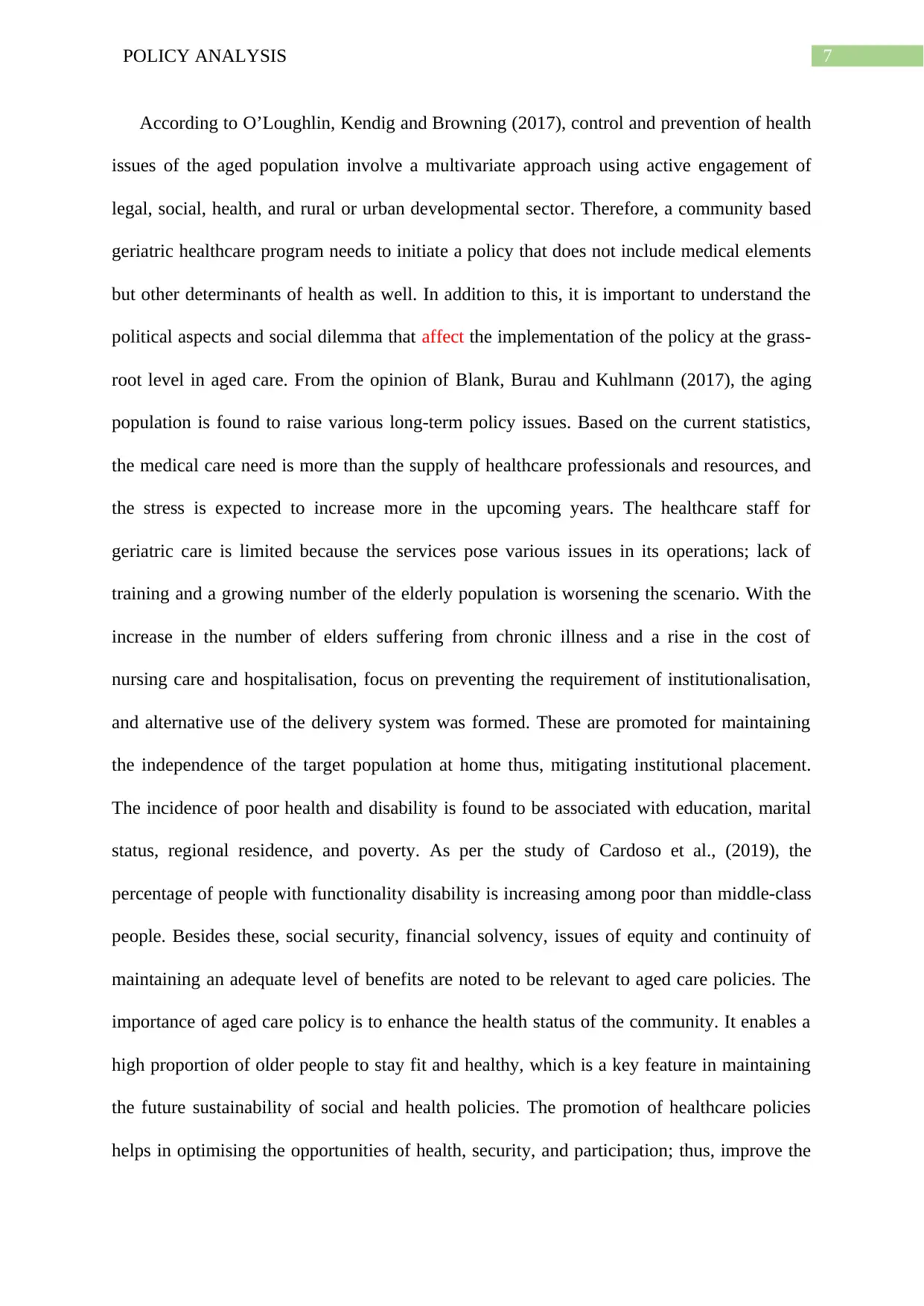
7POLICY ANALYSIS
According to O’Loughlin, Kendig and Browning (2017), control and prevention of health
issues of the aged population involve a multivariate approach using active engagement of
legal, social, health, and rural or urban developmental sector. Therefore, a community based
geriatric healthcare program needs to initiate a policy that does not include medical elements
but other determinants of health as well. In addition to this, it is important to understand the
political aspects and social dilemma that affect the implementation of the policy at the grass-
root level in aged care. From the opinion of Blank, Burau and Kuhlmann (2017), the aging
population is found to raise various long-term policy issues. Based on the current statistics,
the medical care need is more than the supply of healthcare professionals and resources, and
the stress is expected to increase more in the upcoming years. The healthcare staff for
geriatric care is limited because the services pose various issues in its operations; lack of
training and a growing number of the elderly population is worsening the scenario. With the
increase in the number of elders suffering from chronic illness and a rise in the cost of
nursing care and hospitalisation, focus on preventing the requirement of institutionalisation,
and alternative use of the delivery system was formed. These are promoted for maintaining
the independence of the target population at home thus, mitigating institutional placement.
The incidence of poor health and disability is found to be associated with education, marital
status, regional residence, and poverty. As per the study of Cardoso et al., (2019), the
percentage of people with functionality disability is increasing among poor than middle-class
people. Besides these, social security, financial solvency, issues of equity and continuity of
maintaining an adequate level of benefits are noted to be relevant to aged care policies. The
importance of aged care policy is to enhance the health status of the community. It enables a
high proportion of older people to stay fit and healthy, which is a key feature in maintaining
the future sustainability of social and health policies. The promotion of healthcare policies
helps in optimising the opportunities of health, security, and participation; thus, improve the
According to O’Loughlin, Kendig and Browning (2017), control and prevention of health
issues of the aged population involve a multivariate approach using active engagement of
legal, social, health, and rural or urban developmental sector. Therefore, a community based
geriatric healthcare program needs to initiate a policy that does not include medical elements
but other determinants of health as well. In addition to this, it is important to understand the
political aspects and social dilemma that affect the implementation of the policy at the grass-
root level in aged care. From the opinion of Blank, Burau and Kuhlmann (2017), the aging
population is found to raise various long-term policy issues. Based on the current statistics,
the medical care need is more than the supply of healthcare professionals and resources, and
the stress is expected to increase more in the upcoming years. The healthcare staff for
geriatric care is limited because the services pose various issues in its operations; lack of
training and a growing number of the elderly population is worsening the scenario. With the
increase in the number of elders suffering from chronic illness and a rise in the cost of
nursing care and hospitalisation, focus on preventing the requirement of institutionalisation,
and alternative use of the delivery system was formed. These are promoted for maintaining
the independence of the target population at home thus, mitigating institutional placement.
The incidence of poor health and disability is found to be associated with education, marital
status, regional residence, and poverty. As per the study of Cardoso et al., (2019), the
percentage of people with functionality disability is increasing among poor than middle-class
people. Besides these, social security, financial solvency, issues of equity and continuity of
maintaining an adequate level of benefits are noted to be relevant to aged care policies. The
importance of aged care policy is to enhance the health status of the community. It enables a
high proportion of older people to stay fit and healthy, which is a key feature in maintaining
the future sustainability of social and health policies. The promotion of healthcare policies
helps in optimising the opportunities of health, security, and participation; thus, improve the
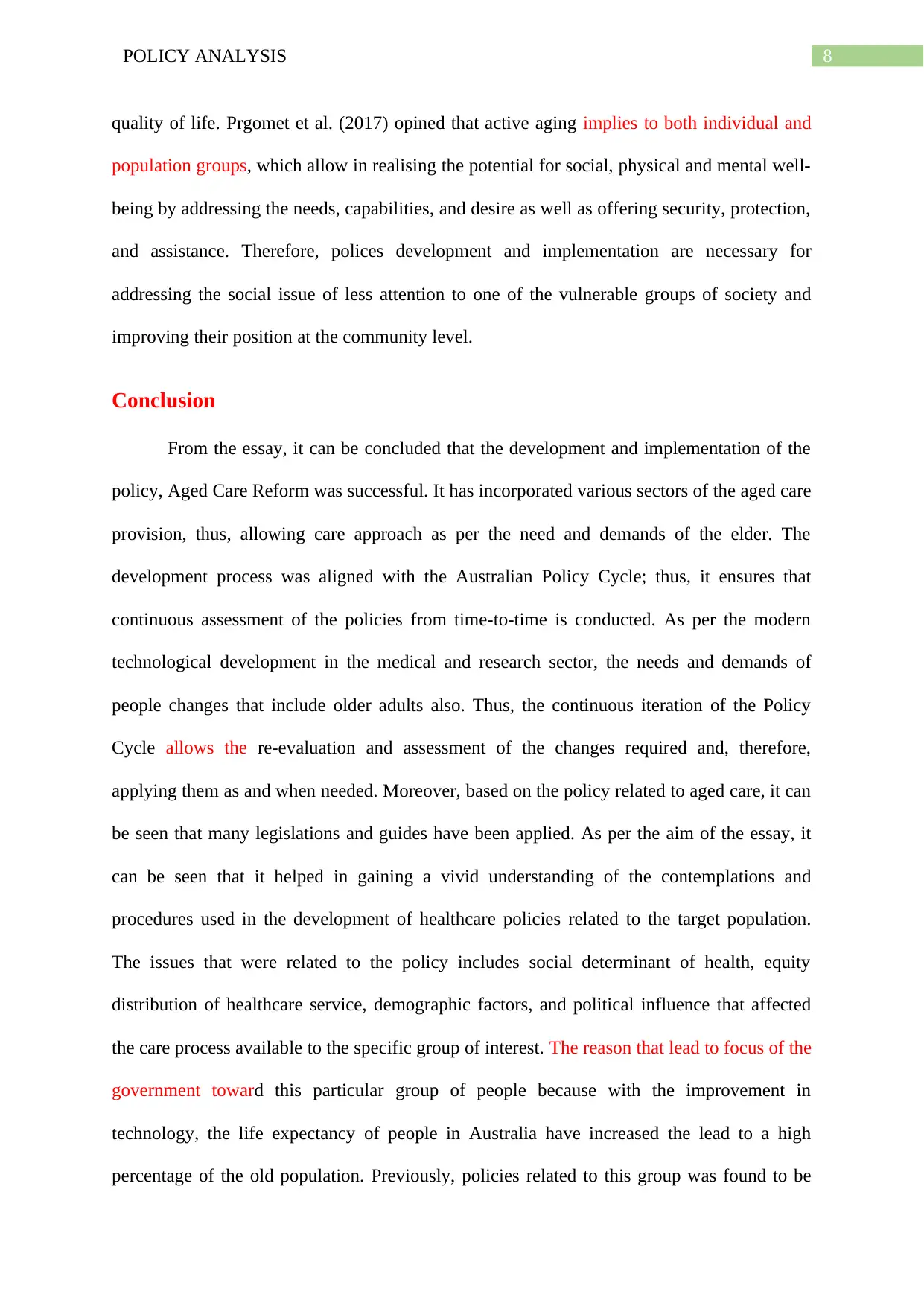
8POLICY ANALYSIS
quality of life. Prgomet et al. (2017) opined that active aging implies to both individual and
population groups, which allow in realising the potential for social, physical and mental well-
being by addressing the needs, capabilities, and desire as well as offering security, protection,
and assistance. Therefore, polices development and implementation are necessary for
addressing the social issue of less attention to one of the vulnerable groups of society and
improving their position at the community level.
Conclusion
From the essay, it can be concluded that the development and implementation of the
policy, Aged Care Reform was successful. It has incorporated various sectors of the aged care
provision, thus, allowing care approach as per the need and demands of the elder. The
development process was aligned with the Australian Policy Cycle; thus, it ensures that
continuous assessment of the policies from time-to-time is conducted. As per the modern
technological development in the medical and research sector, the needs and demands of
people changes that include older adults also. Thus, the continuous iteration of the Policy
Cycle allows the re-evaluation and assessment of the changes required and, therefore,
applying them as and when needed. Moreover, based on the policy related to aged care, it can
be seen that many legislations and guides have been applied. As per the aim of the essay, it
can be seen that it helped in gaining a vivid understanding of the contemplations and
procedures used in the development of healthcare policies related to the target population.
The issues that were related to the policy includes social determinant of health, equity
distribution of healthcare service, demographic factors, and political influence that affected
the care process available to the specific group of interest. The reason that lead to focus of the
government toward this particular group of people because with the improvement in
technology, the life expectancy of people in Australia have increased the lead to a high
percentage of the old population. Previously, policies related to this group was found to be
quality of life. Prgomet et al. (2017) opined that active aging implies to both individual and
population groups, which allow in realising the potential for social, physical and mental well-
being by addressing the needs, capabilities, and desire as well as offering security, protection,
and assistance. Therefore, polices development and implementation are necessary for
addressing the social issue of less attention to one of the vulnerable groups of society and
improving their position at the community level.
Conclusion
From the essay, it can be concluded that the development and implementation of the
policy, Aged Care Reform was successful. It has incorporated various sectors of the aged care
provision, thus, allowing care approach as per the need and demands of the elder. The
development process was aligned with the Australian Policy Cycle; thus, it ensures that
continuous assessment of the policies from time-to-time is conducted. As per the modern
technological development in the medical and research sector, the needs and demands of
people changes that include older adults also. Thus, the continuous iteration of the Policy
Cycle allows the re-evaluation and assessment of the changes required and, therefore,
applying them as and when needed. Moreover, based on the policy related to aged care, it can
be seen that many legislations and guides have been applied. As per the aim of the essay, it
can be seen that it helped in gaining a vivid understanding of the contemplations and
procedures used in the development of healthcare policies related to the target population.
The issues that were related to the policy includes social determinant of health, equity
distribution of healthcare service, demographic factors, and political influence that affected
the care process available to the specific group of interest. The reason that lead to focus of the
government toward this particular group of people because with the improvement in
technology, the life expectancy of people in Australia have increased the lead to a high
percentage of the old population. Previously, policies related to this group was found to be
⊘ This is a preview!⊘
Do you want full access?
Subscribe today to unlock all pages.

Trusted by 1+ million students worldwide
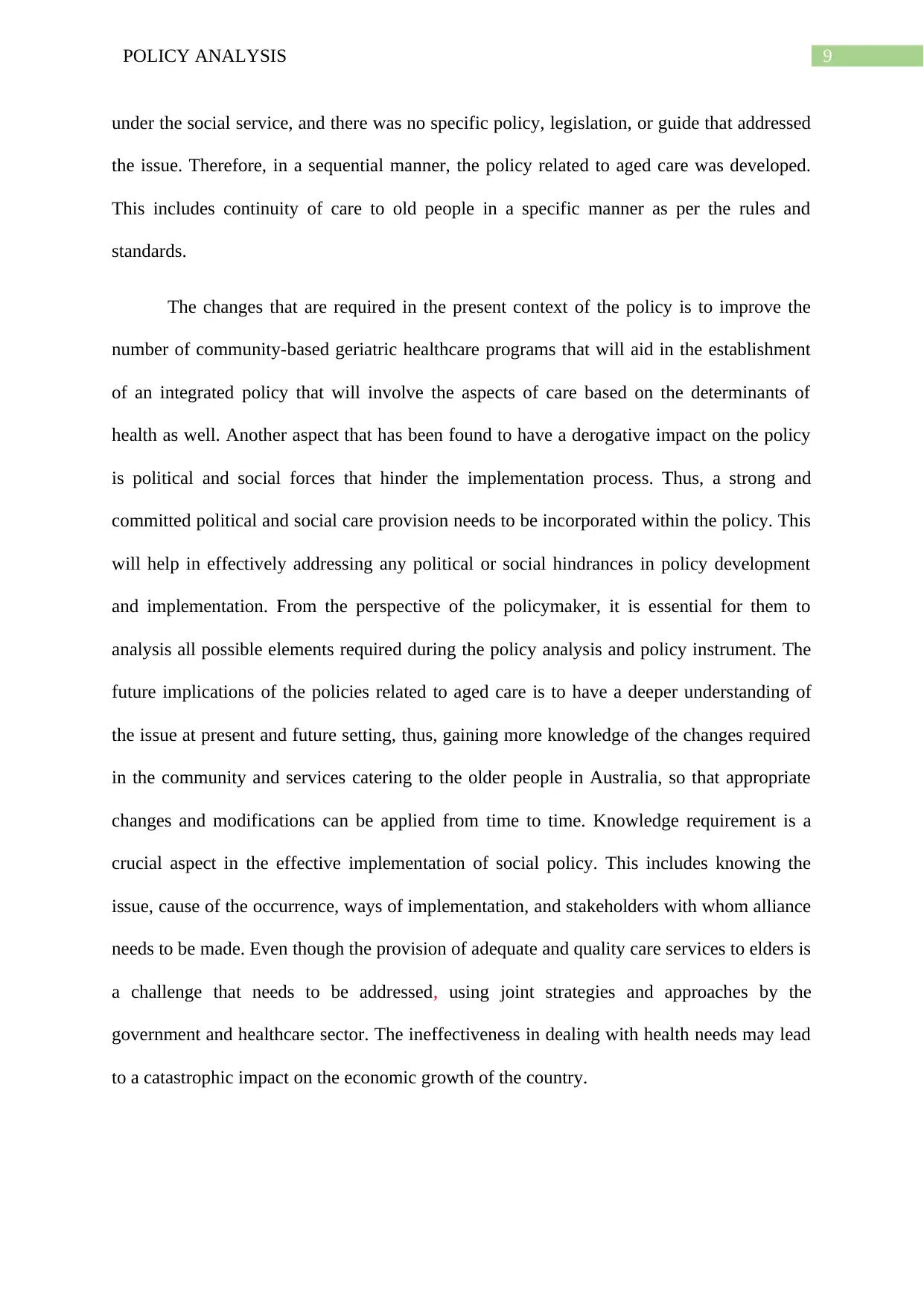
9POLICY ANALYSIS
under the social service, and there was no specific policy, legislation, or guide that addressed
the issue. Therefore, in a sequential manner, the policy related to aged care was developed.
This includes continuity of care to old people in a specific manner as per the rules and
standards.
The changes that are required in the present context of the policy is to improve the
number of community-based geriatric healthcare programs that will aid in the establishment
of an integrated policy that will involve the aspects of care based on the determinants of
health as well. Another aspect that has been found to have a derogative impact on the policy
is political and social forces that hinder the implementation process. Thus, a strong and
committed political and social care provision needs to be incorporated within the policy. This
will help in effectively addressing any political or social hindrances in policy development
and implementation. From the perspective of the policymaker, it is essential for them to
analysis all possible elements required during the policy analysis and policy instrument. The
future implications of the policies related to aged care is to have a deeper understanding of
the issue at present and future setting, thus, gaining more knowledge of the changes required
in the community and services catering to the older people in Australia, so that appropriate
changes and modifications can be applied from time to time. Knowledge requirement is a
crucial aspect in the effective implementation of social policy. This includes knowing the
issue, cause of the occurrence, ways of implementation, and stakeholders with whom alliance
needs to be made. Even though the provision of adequate and quality care services to elders is
a challenge that needs to be addressed, using joint strategies and approaches by the
government and healthcare sector. The ineffectiveness in dealing with health needs may lead
to a catastrophic impact on the economic growth of the country.
under the social service, and there was no specific policy, legislation, or guide that addressed
the issue. Therefore, in a sequential manner, the policy related to aged care was developed.
This includes continuity of care to old people in a specific manner as per the rules and
standards.
The changes that are required in the present context of the policy is to improve the
number of community-based geriatric healthcare programs that will aid in the establishment
of an integrated policy that will involve the aspects of care based on the determinants of
health as well. Another aspect that has been found to have a derogative impact on the policy
is political and social forces that hinder the implementation process. Thus, a strong and
committed political and social care provision needs to be incorporated within the policy. This
will help in effectively addressing any political or social hindrances in policy development
and implementation. From the perspective of the policymaker, it is essential for them to
analysis all possible elements required during the policy analysis and policy instrument. The
future implications of the policies related to aged care is to have a deeper understanding of
the issue at present and future setting, thus, gaining more knowledge of the changes required
in the community and services catering to the older people in Australia, so that appropriate
changes and modifications can be applied from time to time. Knowledge requirement is a
crucial aspect in the effective implementation of social policy. This includes knowing the
issue, cause of the occurrence, ways of implementation, and stakeholders with whom alliance
needs to be made. Even though the provision of adequate and quality care services to elders is
a challenge that needs to be addressed, using joint strategies and approaches by the
government and healthcare sector. The ineffectiveness in dealing with health needs may lead
to a catastrophic impact on the economic growth of the country.
Paraphrase This Document
Need a fresh take? Get an instant paraphrase of this document with our AI Paraphraser
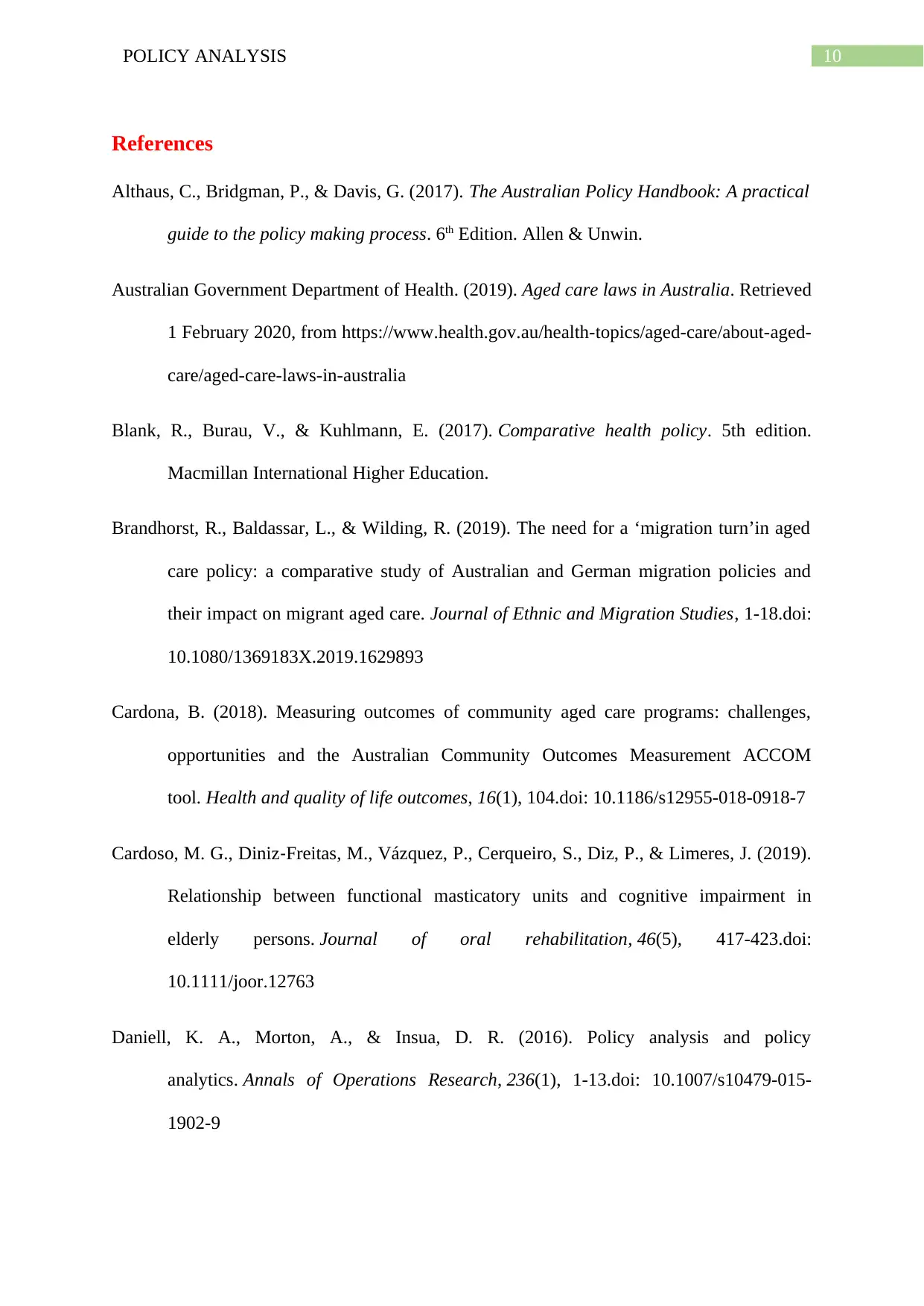
10POLICY ANALYSIS
References
Althaus, C., Bridgman, P., & Davis, G. (2017). The Australian Policy Handbook: A practical
guide to the policy making process. 6th Edition. Allen & Unwin.
Australian Government Department of Health. (2019). Aged care laws in Australia. Retrieved
1 February 2020, from https://www.health.gov.au/health-topics/aged-care/about-aged-
care/aged-care-laws-in-australia
Blank, R., Burau, V., & Kuhlmann, E. (2017). Comparative health policy. 5th edition.
Macmillan International Higher Education.
Brandhorst, R., Baldassar, L., & Wilding, R. (2019). The need for a ‘migration turn’in aged
care policy: a comparative study of Australian and German migration policies and
their impact on migrant aged care. Journal of Ethnic and Migration Studies, 1-18.doi:
10.1080/1369183X.2019.1629893
Cardona, B. (2018). Measuring outcomes of community aged care programs: challenges,
opportunities and the Australian Community Outcomes Measurement ACCOM
tool. Health and quality of life outcomes, 16(1), 104.doi: 10.1186/s12955-018-0918-7
Cardoso, M. G., Diniz‐Freitas, M., Vázquez, P., Cerqueiro, S., Diz, P., & Limeres, J. (2019).
Relationship between functional masticatory units and cognitive impairment in
elderly persons. Journal of oral rehabilitation, 46(5), 417-423.doi:
10.1111/joor.12763
Daniell, K. A., Morton, A., & Insua, D. R. (2016). Policy analysis and policy
analytics. Annals of Operations Research, 236(1), 1-13.doi: 10.1007/s10479-015-
1902-9
References
Althaus, C., Bridgman, P., & Davis, G. (2017). The Australian Policy Handbook: A practical
guide to the policy making process. 6th Edition. Allen & Unwin.
Australian Government Department of Health. (2019). Aged care laws in Australia. Retrieved
1 February 2020, from https://www.health.gov.au/health-topics/aged-care/about-aged-
care/aged-care-laws-in-australia
Blank, R., Burau, V., & Kuhlmann, E. (2017). Comparative health policy. 5th edition.
Macmillan International Higher Education.
Brandhorst, R., Baldassar, L., & Wilding, R. (2019). The need for a ‘migration turn’in aged
care policy: a comparative study of Australian and German migration policies and
their impact on migrant aged care. Journal of Ethnic and Migration Studies, 1-18.doi:
10.1080/1369183X.2019.1629893
Cardona, B. (2018). Measuring outcomes of community aged care programs: challenges,
opportunities and the Australian Community Outcomes Measurement ACCOM
tool. Health and quality of life outcomes, 16(1), 104.doi: 10.1186/s12955-018-0918-7
Cardoso, M. G., Diniz‐Freitas, M., Vázquez, P., Cerqueiro, S., Diz, P., & Limeres, J. (2019).
Relationship between functional masticatory units and cognitive impairment in
elderly persons. Journal of oral rehabilitation, 46(5), 417-423.doi:
10.1111/joor.12763
Daniell, K. A., Morton, A., & Insua, D. R. (2016). Policy analysis and policy
analytics. Annals of Operations Research, 236(1), 1-13.doi: 10.1007/s10479-015-
1902-9
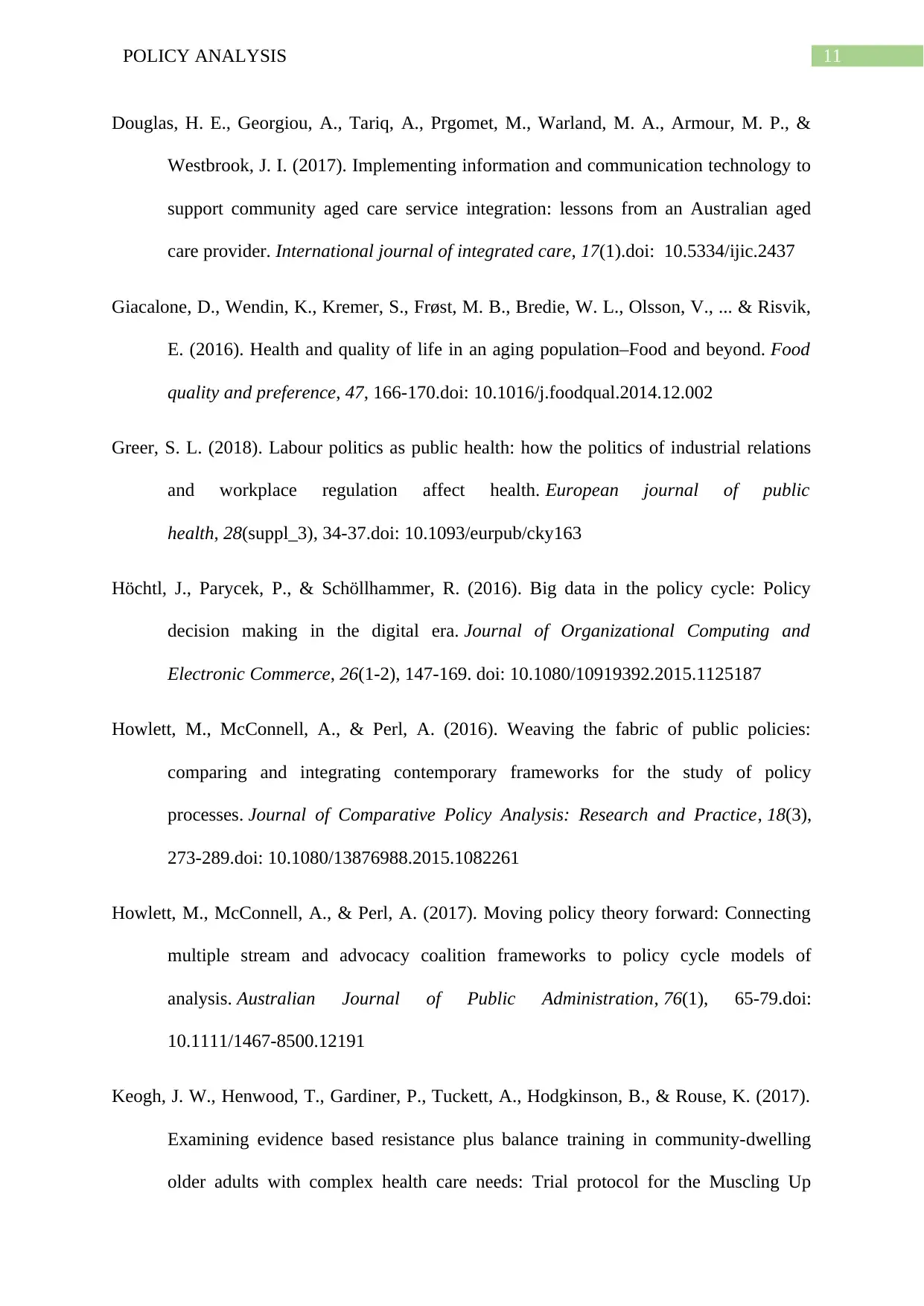
11POLICY ANALYSIS
Douglas, H. E., Georgiou, A., Tariq, A., Prgomet, M., Warland, M. A., Armour, M. P., &
Westbrook, J. I. (2017). Implementing information and communication technology to
support community aged care service integration: lessons from an Australian aged
care provider. International journal of integrated care, 17(1).doi: 10.5334/ijic.2437
Giacalone, D., Wendin, K., Kremer, S., Frøst, M. B., Bredie, W. L., Olsson, V., ... & Risvik,
E. (2016). Health and quality of life in an aging population–Food and beyond. Food
quality and preference, 47, 166-170.doi: 10.1016/j.foodqual.2014.12.002
Greer, S. L. (2018). Labour politics as public health: how the politics of industrial relations
and workplace regulation affect health. European journal of public
health, 28(suppl_3), 34-37.doi: 10.1093/eurpub/cky163
Höchtl, J., Parycek, P., & Schöllhammer, R. (2016). Big data in the policy cycle: Policy
decision making in the digital era. Journal of Organizational Computing and
Electronic Commerce, 26(1-2), 147-169. doi: 10.1080/10919392.2015.1125187
Howlett, M., McConnell, A., & Perl, A. (2016). Weaving the fabric of public policies:
comparing and integrating contemporary frameworks for the study of policy
processes. Journal of Comparative Policy Analysis: Research and Practice, 18(3),
273-289.doi: 10.1080/13876988.2015.1082261
Howlett, M., McConnell, A., & Perl, A. (2017). Moving policy theory forward: Connecting
multiple stream and advocacy coalition frameworks to policy cycle models of
analysis. Australian Journal of Public Administration, 76(1), 65-79.doi:
10.1111/1467-8500.12191
Keogh, J. W., Henwood, T., Gardiner, P., Tuckett, A., Hodgkinson, B., & Rouse, K. (2017).
Examining evidence based resistance plus balance training in community-dwelling
older adults with complex health care needs: Trial protocol for the Muscling Up
Douglas, H. E., Georgiou, A., Tariq, A., Prgomet, M., Warland, M. A., Armour, M. P., &
Westbrook, J. I. (2017). Implementing information and communication technology to
support community aged care service integration: lessons from an Australian aged
care provider. International journal of integrated care, 17(1).doi: 10.5334/ijic.2437
Giacalone, D., Wendin, K., Kremer, S., Frøst, M. B., Bredie, W. L., Olsson, V., ... & Risvik,
E. (2016). Health and quality of life in an aging population–Food and beyond. Food
quality and preference, 47, 166-170.doi: 10.1016/j.foodqual.2014.12.002
Greer, S. L. (2018). Labour politics as public health: how the politics of industrial relations
and workplace regulation affect health. European journal of public
health, 28(suppl_3), 34-37.doi: 10.1093/eurpub/cky163
Höchtl, J., Parycek, P., & Schöllhammer, R. (2016). Big data in the policy cycle: Policy
decision making in the digital era. Journal of Organizational Computing and
Electronic Commerce, 26(1-2), 147-169. doi: 10.1080/10919392.2015.1125187
Howlett, M., McConnell, A., & Perl, A. (2016). Weaving the fabric of public policies:
comparing and integrating contemporary frameworks for the study of policy
processes. Journal of Comparative Policy Analysis: Research and Practice, 18(3),
273-289.doi: 10.1080/13876988.2015.1082261
Howlett, M., McConnell, A., & Perl, A. (2017). Moving policy theory forward: Connecting
multiple stream and advocacy coalition frameworks to policy cycle models of
analysis. Australian Journal of Public Administration, 76(1), 65-79.doi:
10.1111/1467-8500.12191
Keogh, J. W., Henwood, T., Gardiner, P., Tuckett, A., Hodgkinson, B., & Rouse, K. (2017).
Examining evidence based resistance plus balance training in community-dwelling
older adults with complex health care needs: Trial protocol for the Muscling Up
⊘ This is a preview!⊘
Do you want full access?
Subscribe today to unlock all pages.

Trusted by 1+ million students worldwide
1 out of 14
Related Documents
Your All-in-One AI-Powered Toolkit for Academic Success.
+13062052269
info@desklib.com
Available 24*7 on WhatsApp / Email
![[object Object]](/_next/static/media/star-bottom.7253800d.svg)
Unlock your academic potential
Copyright © 2020–2025 A2Z Services. All Rights Reserved. Developed and managed by ZUCOL.





